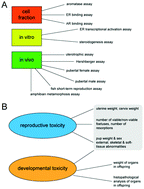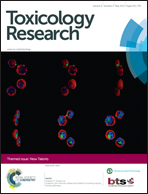Beyond a means of exposure: a new view of the mother in toxicology research
Abstract
Toxicological studies generally view pregnant animals as a conduit through which gestational exposure of offspring to chemicals can be achieved, allowing for the study of developmental toxicity. One class of compounds, endocrine disrupting chemicals (EDCs), has been shown to interfere with hormone signalling in a number of in vivo models, with effects that are more pronounced when exposures occur during development. Yet, evidence has also accumulated that the traditional means of assessing the health effects of EDCs, using test guidelines, are not sufficient to fully capture the effects of these compounds. Our work has focused on the effects of EDCs on more complex, integrated endpoints than the ones typically examined in test guidelines (such as organ weight, histopathology, number of live/dead offspring). Here, we review evidence that EDCs interfere with the display of maternal behaviours, integrated endpoints affected by multiple hormones and other signalling molecules. We discuss a number of assays that can be easily conducted to assess the effects of environmental chemicals on maternal behaviours, as well as molecular assays of the medial preoptic area (MPOA), considered one of the principal regions in the brain responsible for maternal responsiveness. We propose that studies of emerging EDCs of concern should examine maternal behaviours in developmental toxicity tests, and when effects are observed, the maternal brain should be examined as well. We further advise that researchers avoid viewing the mother as simply a means of exposing the group of interest (i.e. the offspring), and instead recognize how the mother can greatly influence the behavioural phenotype and health of her offspring.

- This article is part of the themed collection: New Talents

 Please wait while we load your content...
Please wait while we load your content...